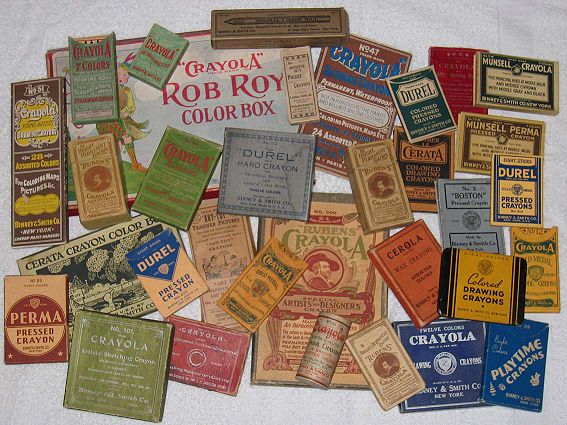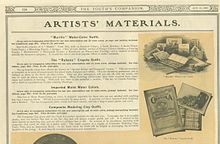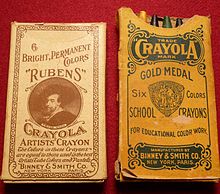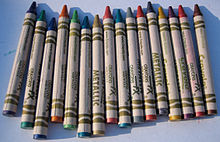- Crayola
-
Crayola LLC 
Crayola logo used since 2003Type Privately held company Industry Arts and crafts, Toys Predecessor E. Binney & H. Smith Founded New York City, New York (1885) Founder(s) Edwin Binney
C. Harold SmithHeadquarters 1100 Church Lane
United States[1]
Forks Township, Northampton County, Pennsylvania 18040Number of locations Manufacturing:[1]
Forks Township, Northampton County, Pennsylvania
Bethlehem, Pennsylvania
Mexico City, Mexico
International sales and marketing offices:[1]
Canada, England, Australia, France, Mexico, Italy and SpainKey people Mike Perry, President and Chief Executive Officer
Dona Fisher, Vice President & Chief Financial Officer
Sharon Hartley, Vice President, U.S. Marketing & Sales
Peter S. Ruggiero, Vice President, Operations[1]Employees 1,250 (2006)[1] Parent Hallmark Cards Divisions Crayola, Silly Putty, Portfolio Series Website http://www.crayola.com/ Crayola is a brand of artists' supplies manufactured by Crayola LLC, which was founded in 1885 as Binney & Smith. It is best known for its crayons. The company is based in Forks Township, Northampton County, Pennsylvania.
Originally an industrial pigment supply company, Crayola soon shifted its focus to art products for home and school use, beginning with chalk, then crayons, followed later by colored pencils, markers, paints, modeling clay, and other related goods. All Crayola-branded products are marketed as nontoxic and safe for use by children.[2]
The company also produces Silly Putty and a line of professional art products under the Portfolio Series brand.
Crayola LLC claims the Crayola brand has 99% name recognition in U.S. consumer households, and says its products are sold in over 80 countries.[3]
Contents
History
See also: Timeline of Crayola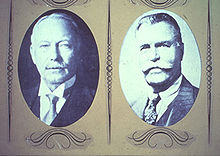 Crayola's founders Edwin Binney (left) and C. Harold Smith (right)
Crayola's founders Edwin Binney (left) and C. Harold Smith (right)
The company was founded by cousins Edwin Binney and C. Harold Smith in New York City in 1885 as Binney & Smith. Initial products were colorants for industrial use, including red iron oxide pigments used in barn paint and carbon black chemicals used for making tires black and extending their useful lifespan.[4] Binney & Smith's new process of creating inexpensive black colorants was entered into the chemistry industries competition at the 1900 Paris Exposition under the title "carbon gas blacks, lamp or oil blacks, 'Peerless' black" and earned the company a gold medal award in chemical and pharmaceutical arts.[5][6] Also in 1900, the company added production of slate school pencils. Binney's experimentation with industrial materials, including slate waste, cement, and talc, led to the invention of the first dustless white chalk, for which the company won a gold medal at the 1904 St. Louis World's Fair.[6]
In 1902, Binney & Smith developed and introduced the Staonal marking crayon. Then Edwin Binney, working with his wife, Alice Stead Binney, developed his own famous product line of wax crayons beginning on 10 June 1903,[7] which it sold under the brand name "Crayola." The Crayola name was coined by Alice Binney, wife of company founder Edwin and a former schoolteacher. It comes from "craie", French for "chalk," and "ola" for "oleaginous", or "oily."[6][8] Crayola introduced its crayons not with one box, but with a full product line. By 1905, the line had expanded to offering 18 different-sized crayon boxes[9] with five different-sized crayons, only two of which survive today - the "standard size" (a standard sized Crayola crayon is 3 5/8" x 5/16") and the "large size" (large sized crayola crayons are 4" x 7/16"). The product line offered crayon boxes contained containing 6, 7, 8, 12, 14, 16, 18, 24, 28, or 30 different color crayons. Some of these boxes were targeted for artists and contained crayons with no wrappers, while others had a color number printed on the wrapper that corresponded to a number on a list of color names printed inside the box lid, but some boxes contained crayons with their color names printed on their wrappers.
The Rubens Crayola line, started in 1903 (not in the 1920s, as claimed by some sources),[10] was directly targeted at artists and designed to compete with the Raphael brand of crayons from Europe. The crayon boxes sold from five cents for a No.6 Rubens box containing six different-colored crayons to $1.50 for the No. 500 Rubens Special Artists and Designers Crayon box containing 24 different-colored, larger (4 1/4" x 1/2") crayons.[11]
In April 1904 at the St. Louis World's Fair, Binney & Smith won the Gold Medal for their An-Du-Septic dustless chalk. Receiving a medal at an Exposition was and still of importance, with companies featuring their medals on their products. Two companies to use the 1904 medal were Jack Daniel's whiskey (which still use it on their bottles to this day) and Binney & Smith.[12] Subsequently, Crayola used the opportunity to develop a new packaging strategy by emphasizing their gold medal on the front of many of their products and crayon boxes. This strategy turned out to be so successful and recognizable to their brand that they phased out nearly all of their other Crayola line box designs to adapt to the gold medal format. The gold medal branding appeared on their packaging for the next 50-plus years.
In 1905, the prototype offering of their new No. 8 crayon box (with eight crayons) from their Gold Medal line featured a copy from the side of the medal with an eagle on it. This was changed to the other side of the medal with the 1904 date on it in Roman numerals.
Crayola also began to either phase out boxes or adapt new ones incorporating the Gold Medal design.
Binney & Smith purchased the Munsell Color Company crayon product line in 1926, and inherited 22 new colors, 11 in the maximum and 11 in the middle hue ranges.[13][14] They retain the Munsell name on products such as “Munsell-Crayola” and “Munsell-Perma” until 1934, and then incorporated their colors into their own Crayola Gold Medal line of boxes.[15]
In 1939, Crayola, by combining its existing crayon colors with the Munsell colors, introduced its largest color assortment product to date; a "No. 52 Drawing Crayon 52 Color Assortment", which was retired by the 1944 price list.
In 1949, Crayola introduced the "Crayola No. 48" containing 48 color crayons in a "stadium seating" box.
Further expansion took place in 1958 with the introduction of the 64-color pack that included the company's first crayon sharpener built into the box. [16] The 64-color box was called "a watershed" moment in the history of the Crayola crayon by Smithsonian National Museum of American History curator David Shayt.[17]
In addition to Binney & Smith's familiar Crayola line, it also made other crayon lines, including Anti-Roll, Arista, Art-Toy, Besco, Boston, Cerata, Cerola, Chic’ago, Doo Zee, Durel, Easy-Off, Gotham, Liquitex, Munsell Crayola, Perma, Pooh, Protfolio, Rubens, Spectra, Tiny Tots, Washable, and Widstrok.[18]
In 1977, Binney & Smith acquired the rights to Silly Putty.[19] Crayola markers were introduced in 1978 to coincide with the 75th anniversary of Crayola crayons. Colored pencils and a line of washable markers were added in 1987.[4]
Crayola Crayons were inducted into the National Toy Hall of Fame at The Strong in Rochester, New York, in 1998.
Crayons
Crayola crayon packs vary in package counts of just a few crayons sold to establishments such as hotels and restaurants, to hand out to their young guests[20] to 832-crayon "Classpack" bulk boxes marketed to schools.[21] The colors contained in a package have ranged from two to 200 (although a 200-color package includes "special effect" crayons such as glitters, neons, etc.). The most common retail packages are multiples of eight, with 8, 16, 24, 32, 48, 64, 96, and 120 packs being marketed today.[22][23][24] A 150-crayon pack featuring a plastic telescope-like case was introduced in 2006, and includes 118 regular color crayons, 16 glitter crayons, and 16 "Metallic FX" crayons, as well as a built-in sharpener at the apex of the tower.[25]
Colors
Further information: List of Crayola crayon colorsAs the size of Crayola crayon packs increased from the original 1903 crayon packs, the variety of colors available has also increased — reaching 120 colors by 1998. Since 1998, new colors have been added, but always replacing existing colors. In all, 13 colors have been retired, bringing the total number of regular colors produced since 1958 to 133.
The 13 officially retired crayon colors are "Blue Gray", "Lemon Yellow", "Orange Red", "Orange Yellow", "Violet Blue", "Maize", "Green Blue", "Raw Umber", "Thistle", "Blizzard Blue", "Mulberry", "Teal Blue", and "Magic Mint".
Some colors have been renamed rather than replaced, often due to cultural sensitivity issues. For example, "Flesh" was changed to "Peach", since not all people have the same hued complexion, and "Indian Red" was changed to "Chestnut" out of concern that the name might be thought to be a reference to the skin color of Native Americans, although the name actually referred to a red pigment from India.[26] "Prussian Blue" was renamed "Midnight Blue", since Prussia had long since ceased to exist and the name had fallen into disuse.
The following colors are included in the 8, 16, and 24 packs:
Special ColorsMetallic FX
In 2001, Crayola released its Metallic FX specialty crayons featuring metallic colors; the new set of crayons were named by Americans and Canadians via mail-in vote.
Glitter
Black With Glitzy Gold Glitter, Blue With Shimmering Silver Glitter, Blue Green with Glitzy Gold Glitter, Carnation Pink With Lavender Glitter, Green With Twinkling Turquoise Glitter, Maroon With Glitzy Gold Glitter, Orange With Twinkling Turquoise Glitter, Orchid With Twinkling Turquoise Glitter, Red With Shimmering Silver Glitter, Red Violet With Glitzy Gold Glitter, Royal Purple With Ruby Red Glitter, Sky Blue With Glitzy Gold Glitter, White With Confetti Glitter, White With Glitzy Gold Glitter, Yellow With Rainbow Glitter, Yellow Green With Silver Glitter
Specialty crayons
Crayola has added other specialty products to its lineup, including scented, washable, triangular-shaped, sidewalk, twistable, window, and oversized crayons.[22]
Cultural impact
A Yale University study found the scent of Crayola crayons is one of the most recognizable scents for adults,[6] ranking at number 18, trailing coffee and peanut butter that were number one and two respectively, but beating out cheese and bleach, which placed at 19 and 20.[27]
The Smithsonian National Museum of American History maintains a collection of Crayola crayons founded by an original 64-color box donated by Binney & Smith in 1998. The collection now includes more than 300 boxes of crayons.[17]
The Crayola crayon was inducted into the National Toy Hall of Fame as a founding member at its inception.
Crayola has been featured in segments from the popular children's shows Sesame Street[28] and Mister Rogers' Neighborhood, with the official 100 billionth crayon molded by Fred Rogers himself in February 1996 at the plant in Easton.[29]
Commemorative postage stamp
 1998 USPS stamp commemorating Crayola crayons. Note the Roman numeral date "MCMIV" at the bottom of the gold medal seal
1998 USPS stamp commemorating Crayola crayons. Note the Roman numeral date "MCMIV" at the bottom of the gold medal seal
In 1998, the United States Postal Service issued a 32-cent postage stamp to commemorate the cultural impact the product has had on almost all Americans.[30] Although the crayons debuted in 1903 and the stamp is titled as such, the box depicted includes the 1904 St. Louis World's Fair Gold Medal insignia (dated MCMIV) won by Binney & Smith for their dustless chalk,[6] so it can not be the original 1903 package design.
The stamp is part of the 1900s decade sheet of the Celebrate the Century souvenir sheet series, and was designed by Carl Herrman, illustrated by Richard Waldrep and printed by Ashton-Potter USA using the offset/intaglio process.[31]
Crayola color census 2000
In 2000, Crayola held the "Crayola Color Census 2000" promotion in which Americans were asked to vote for their favorite Crayola crayon color. Celebrity entrants George W. Bush chose "Blue Bell," Tiger Woods chose "Wild Strawberry," and Courteney Cox Arquette chose "Red."[32] Overall, "Blue" came in first, with "Cerulean" second and "Purple Heart" third.[33] Full results are available here.[34]
The Crayola factory
The Crayola factory is located at 30 Centre Square, Easton, Pennsylvania, USA, at Two Rivers Landing,[35] separate from the main manufacturing plant in the same city. The factory is open to the public. Despite its name, the factory is not a manufacturing plant, but rather a museum and visitor center geared toward familiarizing guests with Crayola's history and products.[36]
A "discovery center" was built that showcases the manufacturing process of crayons. There is also a "Crayola Hall of Fame" in which the retired crayon colors are displayed.[37]
The Crayola Factory was featured in a Food Network episode of Dinner: Impossible. A dinner was held for 150 employees of the Crayola Factory to celebrate the 50th anniversary of the 64 -box of crayons. Chef Michael Symon's mission was to create an eight-course tasting menu for this event, where all eight items of the menu had to match eight randomly chosen Crayola crayon colors.[38]
In October 2003, the Factory unveiled "The World's Largest Crayon," a 15-foot crayon weighing 1,500 lb as part of its celebration of 100 years of Crayola crayons. The giant crayon is blue, and was made of leftover crayon bits sent in by children across the United States.[39]
From 2007 to 2009, Ryan Canfield served as the Factory's mascot, "Tip".
Fine art
Although marketed to children and amateur artists, several professional artists have specialized in using Crayola crayons as their primary medium. Don Marco, who works with Crayola crayons and construction paper, is one of the better known crayon artists — having sold over one million prints of his original artworks.[40]
Other products
Crayola LLC produces a broad range of products other than their famous crayons under the Crayola brand name. These include colored pencils, markers, inks and paints, modeling clays, coloring books, and artists' tools. As with all Crayola products, these are all marketed as nontoxic and safe for use by children.[41]
Other brands
Silly Putty
Main article: Silly PuttySilly Putty is a silicone polymer children's toy used for various purposes. Silly Putty was inducted into the National Toy Hall of Fame in 2001.
Portfolio Series
The Portfolio Series is a line of water-soluble oil pastels, watercolors, drawing pencils, colored pencils, and acrylic paints marketed to artists and educators.[42]
Liquitex
Binney & Smith acquired the Liquitex corporation, a producer of fine art supply products, in 1964, but sold it to the ColArt company in 2000.[43]
Licensing
Numerous products, ranging from bath and personal care items to bedding and electronics, are produced by other companies using the Crayola brand name under license.[44]
Christmas Lights
In the 1996–1997 season, Crayola produced Christmas lights using its name with colors such as pink, orange, blue, gold, and red.
Corporate information
Initially formed as a partnership in 1885, Binney & Smith incorporated in 1902. The corporation became a publicly-traded company under the symbol BYS on the American Stock Exchange in 1963, and later moved to the New York Stock Exchange under the same symbol in 1978.[4] In 1984, the company was acquired by the Hallmark Cards company, a privately held corporation.[1] On 1 January 2007, the "Binney & Smith" moniker was retired in favor of the "Crayola LLC" corporate name to showcase the company's well-known brand, which is in use in more than 80 countries and had 99% name recognition in U.S. consumer households.[3]
Manufacturing
Crayola has manufacturing plants in Forks Township, Northampton County, Pennsylvania, Bethlehem, Pennsylvania and Mexico City, Mexico.The colored pencils are made by Faber-Castell Brazilian plants.
Financial data
Because Crayola LLC is a privately held company, it is not required to release detailed financial data publicly.
References
- ^ a b c d e f "Crayola company profile". http://www.crayola.com/corporate/index.cfm. Retrieved 2009-06-26.
- ^ "Our Commitment to Crayola Product Safety". Crayola. http://www.crayola.com/productsafety/index.cfm. Retrieved 2009-06-24.
- ^ a b "Binney & Smith becomes Crayola LLC". Binney & Smith. http://www.binney-smith.com/. Retrieved 2009-06-26.
- ^ a b c Kathryn DeVan (Fall 2008). "Crayola Colors Children’s Memories in 64 Shades and More". Pennsylvania State University. http://pabook.libraries.psu.edu/palitmap/Crayola.html. Retrieved 2009-06-26.
- ^ Catalogue of Exhibitors in the United States Sections of the International Universal Exposition Paris, 1900. Paris: Société Anonyme des Imprimeries Lemercier. 1900. p. 425. http://books.google.com/books?id=wEU1AAAAMAAJ&lpg=PA425&ots=OXfMEgKwRL&dq=1900%20paris%20exposition%20binney%20smith&pg=PA425. Retrieved 2009-06-22.
- ^ a b c d e "The Colors of Childhood". Smithsonian Magazine. November 1999. http://www.smithsonianmag.com/history-archaeology/object_nov99.html. Retrieved 2009-06-22.
- ^ The Official Gazette of the United States Patent Office. Vol 105. Washington, DC: Government Printing Office. Jul-Aug, 1903. p. 968. http://books.google.com/books?id=cMt8AAAAMAAJ&pg=RA1-PA968&dq=Crayola&lr=&as_drrb_is=b&as_minm_is=0&as_miny_is=1903&as_maxm_is=0&as_maxy_is=1905&as_brr=0&ei=jj2NS7mgOp6mlASmxZ3lDQ&cd=13#v=onepage&q=Crayola&f=false.
- ^ Kitchel, A.F. (1961). The Story of a Rainbow. Easton, PA: Crayola LLC.
- ^ New York Teachers Monographs. Vol 7 (No 1 ed.). New York, NY: American Book Company. March 1905. p. 125. http://books.google.com/books?id=0dxNAAAAMAAJ&pg=RA1-PA125&dq=Crayola&lr=&as_drrb_is=b&as_minm_is=0&as_miny_is=1905&as_maxm_is=0&as_maxy_is=1905&as_brr=0&ei=xkqNS77QJ4OUlATVr8SWDQ&cd=2#v=onepage&q=Crayola&f=false.
- ^ The Art of “Crayola” Painting. Easton, PA: Binney & Smith. 1904.
- ^ The Youth’s Companion. Boston, MA: Perry Mason & Co.. October 18, 1906. p. 524.
- ^ "Gold Medals Louisiana Purchase Exposition 1904". http://www.tlaupp.com/goldMedal.html.
- ^ "American Scientist". http://www.americanScientist.org/my_amsci/restricted.aspx?act=pdf&id=3644245056075.
- ^ Crayons Chalk Water Colors. New York, NY: Binney & Smith Co.. 1927. pp. 13–14.
- ^ Crayons Chalk Water Colors. New York, NY: Binney & Smith Co.. 1934.
- ^ "The Colors of Childhood". http://www.smithsonianmag.com/history-archaeology/object_nov99.html.
- ^ a b Elizabeth Armstrong Hall. American Icons -- Crayola Crayon. Dennis Hall. pp. 180–183. http://books.google.com/books?id=KlxHgYqgDswC&pg=PA180.
- ^ "Known Binney & Smith crayon products". http://www.crayonCollecting.com/ContainerList.xls.
- ^ "Silly Putty History". Crayola. http://www.crayola.com/mediacenter/index.cfm?display=press_release&news_id=164. Retrieved 2009-06-26.
- ^ "Crayons — Hospitality packs, regular crayons, and bulk packs". hotelfun4kids.com. http://www.hotelfun4kids.com/hoteProducts/craft/crayon.htm#CRAYONS.
- ^ "Crayola Crayon Classroom Packs". Dick Blick Art Materials. http://www.dickblick.com/products/crayola-crayon-classpacks/. Retrieved 2009-06-26.
- ^ a b "Draw & Color Crayons". CrayolaStore.com. http://www.crayolaStore.com/product_list.asp?SKW=DRAWCRAYONS&NAV=DRAW&..
- ^ "Crayola crayons 32 pack". OfficeMax. https://www.giftLandOfficeMax.com/School-Supplies/Crayola-Crayons-32-Pack-5901/. Retrieved 2009-06-26.
- ^ "Crayola 120ct Original Crayons". Amazon.com. http://www.amazon.com/Binney-Smith-52-6920-Crayola-Original/dp/B00000J0NT.
- ^ "Crayola Telescoping Crayon Tower - 150ct. (52-0029)". CrayolaStore.com. http://www.crayolaStore.com/product_detail.asp?T1=CRA+52%2D0029&.. Retrieved 2009-06-26.
- ^ "Crayola Crayon Chronology". Crayola LLC. http://www.crayola.com/colorCensus/history/chronology.cfm. Retrieved 2009-07-14.
- ^ "The 20 Most Recognizable Scents In The World". list of the day. http://listoftheday.blogspot.com/2009/05/20-most-recognizable-scents-in-world.html. Retrieved 2009-06-26.
- ^ "Sesame Street: How Crayons are Made". Children's Television Workshop. http://www.youtube.com/watch?v=HMU-wXsgyR8.
- ^ "Crayola Celebrates 100 Years — Did You Know...". Crayola. http://www.crayola.com/mediaCenter/index.cfm?display=press_release&news_id=76. Retrieved 2009-07-14.
- ^ "Crayola Crayons (I Remember JFK: A Baby Boomer's Pleasant Reminiscing Spot)". http://www.iRememberJFK.com/mt/2008/09/crayola_crayons.php. Retrieved 2008-10-19.
- ^ "1900s Celebrate The Century Issues". Smithsonian National Postal Museum. http://arago.si.edu/index.asp?con=1&cmd=1&tid=2041381. Retrieved 2009-06-16.
- ^ "Crayola Color Census 2000; Make Your Color Count in Cyber-Search for America's Favorite Crayon Colors". PRNewswire. 2000-08-07. http://www.PRnewswire.com/cgi-bin/stories.pl?ACCT=104&STORY=/www/story/08-07-2000/0001284896. Retrieved 2009-06-23.
- ^ "Crayola Color Census 2000". Crayola. http://www.crayola.com/colorcensus/bureau/overall_view_120.cfm. Retrieved 2009-06-26.
- ^ Crayola Creativity Central™
- ^ "Directions to The Crayola FACTORY". http://www.crayola.com/factory/directions.cfm. Retrieved 2009-06-26.
- ^ "The Crayola FACTORY at Two Rivers Landing". http://www.crayola.com/factory/index.cfm. Retrieved 2009-06-26.
- ^ The Crayola Factory
- ^ Crayon Craziness: Dinner: Impossible
- ^ "Crayola Factory". RoadsideAmerica.com. http://www.roadsideAmerica.com/story/3644. Retrieved 2009-06-26.
- ^ Ann Cathryn Orsinger. "Artist spotlight: crayon artist Don Marco". Cowboys & Indians Magazine. http://www.cowboysIndians.com/art-entertainment/art-galleries/2009-04/gt-marco.jsp. Retrieved 2009-09-21.
- ^ "Crayola Products". http://www.crayola.com/products/index.cfm?n_id=3. Retrieved 2009-06-26.
- ^ "Portfolio Series Products". http://www.portfolioseries.com/product/. Retrieved 2008-02-26.
- ^ "THE HISTORY OF LIQUITEX ACRYLIC ART MATERIALS". http://www.liquitex.com/aboutliquitex/history.cfm. Retrieved 2009-07-18.
- ^ "Licensing: Crayola Plans To Think Out Of The (Crayon) Box". All Business. 2004-06-07. http://www.allbusiness.com/marketing-advertising/branding-brand-development/4686875-1.html. Retrieved 2009-07-15.
External links
- Official site
- Official UK site
- Orange: A Crayola raw materials data sheet from the 1970s Smithsonian Institution Libraries
Hallmark Cards Key personnel Divisions Crayola · Crown Media Holdings (Hallmark Channel · Hallmark Movie Channel · PixL) · Hallmark Business Expressions · Hallmark Insights · Halls Kansas City · Litho-KromeRelated topics Categories:- Art and craft toys
- Bethlehem, Pennsylvania
- Companies established in 1885
- Crayola
- Easton, Pennsylvania
- Privately held companies based in Pennsylvania
- American brands
- Manufacturing companies based in Pennsylvania
- Toy companies of the United States
- Visitor attractions in Northampton County, Pennsylvania
- National Toy Hall of Fame inductees
Wikimedia Foundation. 2010.

